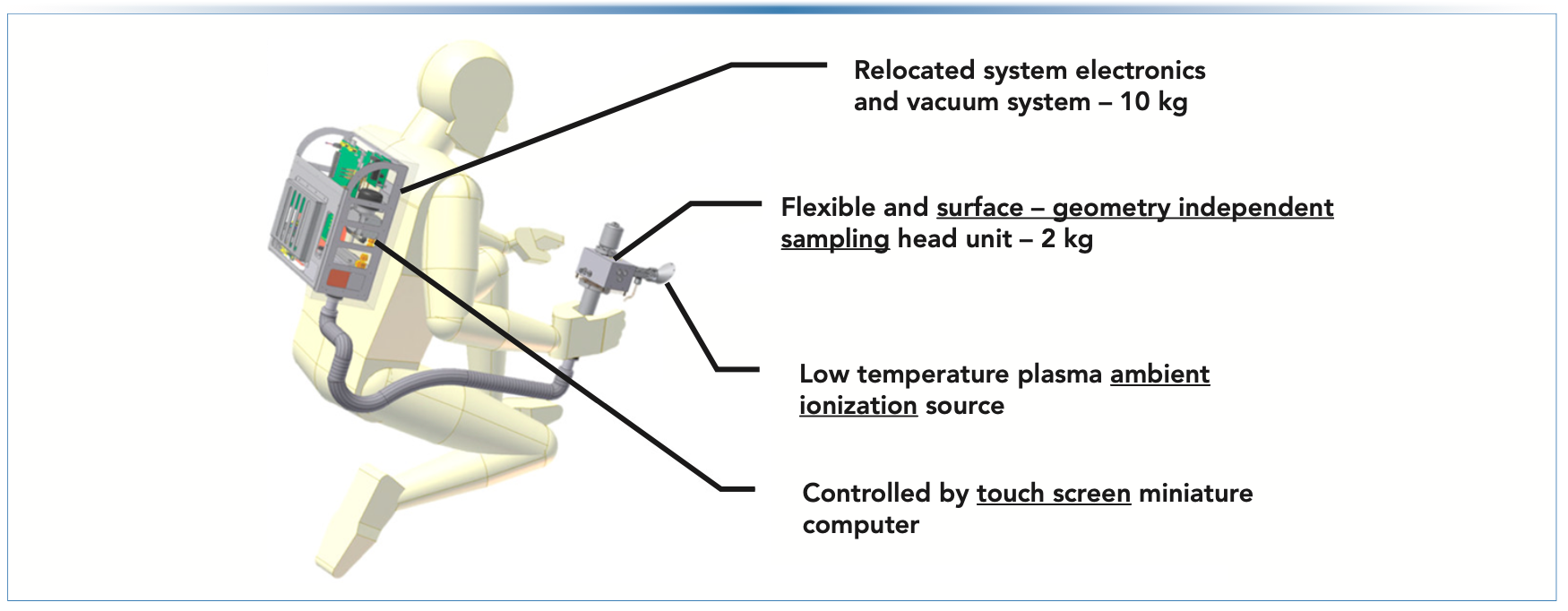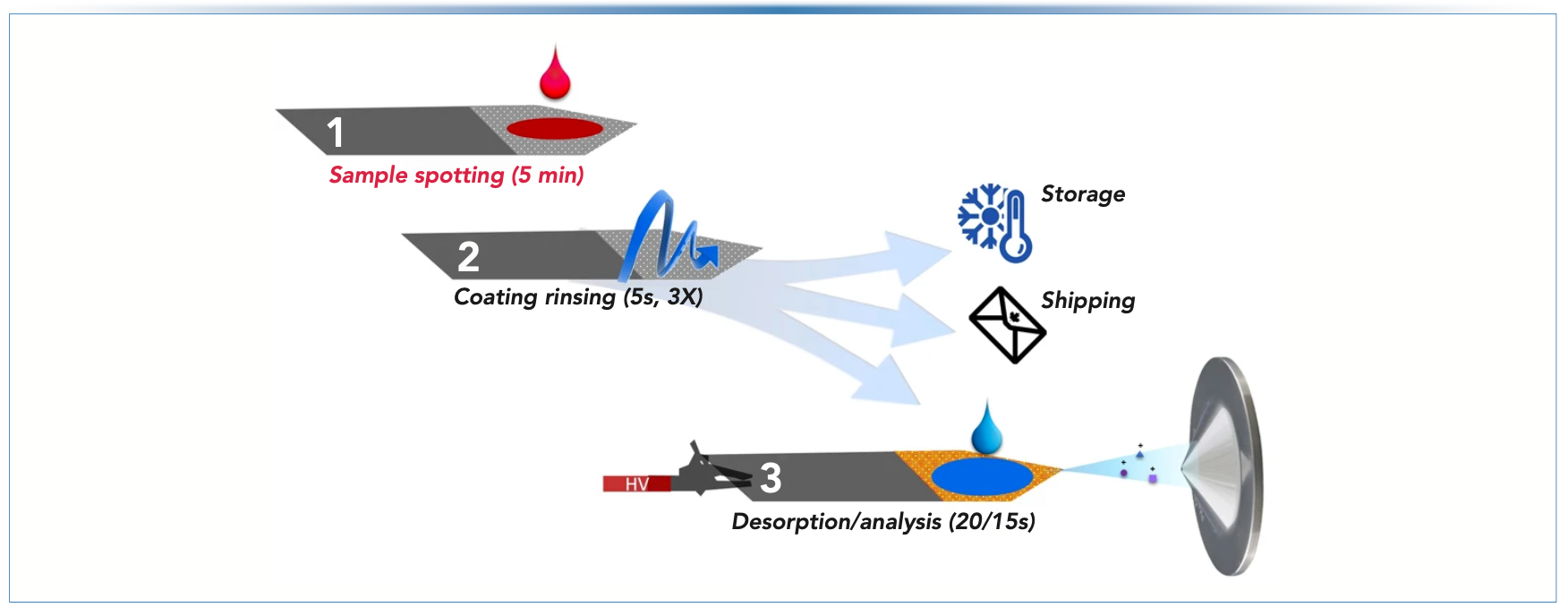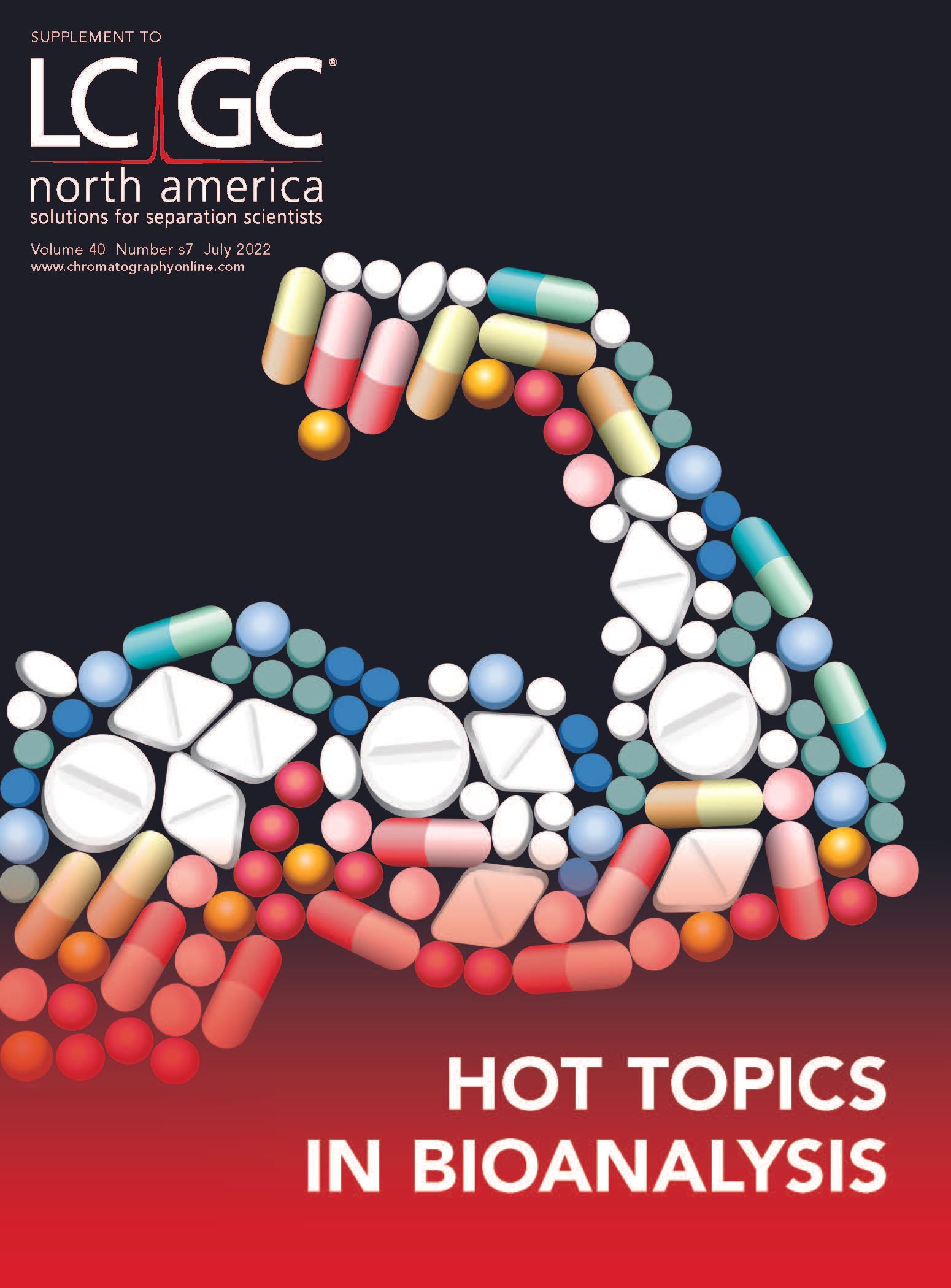Deployable Mass Spectrometry for Rapid On-Site Bioanalysis
Benchtop liquid chromatography (LC)–mass spectrometry (LC–MS) and benchtop gas chromatography–MS (GC–MS) have been the gold standard in bioanalysis for decades, employed in clinical, forensic, and anti-doping laboratories worldwide. However, traditional instrumentation is subject to limitations that severely restrict the speed at which samples can be analyzed, the ease with which materials can be prepared, and the location where the analysis must be performed. With the advent of ambient ionization and portable mass spectrometers, the ability to perform rapid, on-site analysis is fast becoming a reality. Without the need for extensive sample preparation, analysis times as low as several seconds, and the ability to perform analysis remote from the laboratory, deployable mass spectrometers have the potential to revolutionize bioanalysis. However, several challenges must be tackled before this innovative technology can be widely adopted.
In the field of biochemical analysis, liquid chromatography–mass spectrometry (LC–MS) and gas chromatography–MS (GC–MS) have become essential tools for identifying and quantifying analytes in biological matrices. They are widely used in clinical laboratories for diagnostics, in anti-doping for detecting controlled performance-enhancing substances, and in forensics for detecting illicit substances, to name a few application areas. Despite the widespread use of these crucial techniques, there are several key limitations of traditional MS approaches that warrant the development of alternative technologies.
Biological samples, such as blood and urine, are highly complex, containing an abundance of interfering analytes. As such, raw samples are not amenable to analysis by LC–MS or GC–MS, necessitating sample cleanup, extraction, and, in some cases, chemical derivatization. Such sample preparation steps can be laborious, are highly invasive to the sample, and can be costly. Traditional techniques employ chromatography for the separation of sample components. Although important for the accurate identification and quantification of compounds, the chromatographic separation of analytes is a time-consuming process, with some run times being more than an hour per sample. In addition, these techniques can be costly and necessitate the use of expensive gases and solvents and, in the case of LC, environmentally damaging through the substantial quantities of solvent waste. Given the relatively large footprint of some instruments and the need for gas supplies and vacuum pumps, traditional mass spectrometers are by no means portable. As a result, samples must be transported to the laboratory for analysis, inevitably taking time and often necessitating specific storage and transportation requirements, such as low temperatures to preserve the biological materials.
Given the growing need for high-throughput and even portable analysis, recent developments in analytical technology have the potential to revolutionize bioanalysis both in the laboratory and in the field.
Ambient Ionization and Portable Mass Analyzers in Bioanalysis
Over the past two decades, an astonishing amount of research has focused on pushing analytical techniques from the laboratory into the field (1). Research has targeted both the development of novel ion sources and miniaturized mass analyzers suitable for on-site analysis. Ambient ionization mass spectrometry (AIMS) techniques utilize ion sources capable of functioning in the ambient air, eliminating the need for hefty pumps to maintain vacuum. AIMS allows for the rapid, direct analysis of solids, liquids, and gases without lengthy sample-preparation procedures or time-consuming chromatographic separations. When combined with portable mass spectrometers, miniaturized analyzers are capable of being transported in the back of a vehicle or even as a backpack, which is shown in Figure 1 (2). Combining AIMS with portable mass spectrometers creates and forms a powerful new toolkit that has the potential to change the way we can deploy analytical testing across countless fields of study.
FIGURE 1: Schematic of a miniature backpack mass spectrometer with a user-friendly, handheld plasma-based ionization source. Adapted with permission from Hendricks and others (2).

The potential utility of AIMS in the clinical area (that is, to perform rapid diagnostics of different diseases or to achieve the near-real-time measurement of medicines in the body) was identified in the early days of AIMS development. Despite the growing number of AIMS techniques available, a few key techniques have been demonstrated to be particularly useful in clinical bioanalysis. For example, paper spray ionization (PSI) coupled to MS (PSI-MS) is an ambient ionization technique that involves the application of a sample to a triangular piece of paper in front of the mass spectrometer inlet. The subsequent application of a high voltage induces near-instantaneous ionization and detection of analytes. Developed by the Cooks group in 2010 (3), early applications of PSI focused on therapeutic drug monitoring, which demonstrated the ability to rapidly detect a range of medicinal drugs in dried blood (4,5). The technique has since been highlighted as a potential tool in biomarker discovery and disease diagnostics, suitable for the analysis of both body fluids and tissue samples (6,7). Although these studies coupled PSI with benchtop mass spectrometers, other studies have successfully utilized PSI with portable instrumentation for analyzing drugs as bulk materials (8–10) and in dried blood spots and urine (5,10,11). As an alternative electrospray (ES)-based AIMS technique, probe ES ionization (PESI) incorporates a solid needle that is simply dipped into a sample and positioned in front of the mass spectrometer inlet. Then, a high voltage is applied to induce ionization and instantaneous analyte detection. Developed by Hiraoka and others in the mid-2000s (12), PESI was found to be a versatile technique for the direct analysis of raw biological fluids (13–15) and body tissues, particularly for the differentiation of cancerous and healthy tissue samples (16,17).
More recently, the potential use of AIMS for real-time analysis in anti-doping has been identified. In sports, the use of performance-enhancing substances by athletes is strictly controlled by the World Anti-Doping Agency (WADA). Analytical techniques such as LC–MS are employed for the detection of prohibited substances and their metabolites in biological samples, particularly urine and blood. Given the number of athletes tested during major sporting events, deployable and rapid analytical testing would be of substantial benefit to the field. Some early efforts have been made to apply such techniques in this area, with the atmospheric pressure solids analysis probe (ASAP) being a prime candidate as the technique of choice in anti-doping. ASAP-MS incorporates a sampling probe that is introduced to the sample matrix and then exposed directly to the plasma of an atmospheric pressure chemical ionization (APCI) source (18). The technique was most recently demonstrated for the rapid (1 min) analysis of anabolic steroid esters with automated data processing using a commercially available compact ASAP-MS system (19). This system incorporates the efficient functionality of ASAP, a compact transportable mass analyzer, and a simple real-time sample classification system, all suitable for use by a non-expert. Importantly, this particular instrument (Waters Radian ASAP-MS) can be purchased with an built-in diaphragm pump, meaning that the entire system is available within a single unit with only the need for an external nitrogen gas source. Although this model offers reduced sensitivity over a rotary pump alternative, the all-in-one approach offers a distinct advantage when considering “deployability” of an instrument. Despite the clear potential of AIMS in anti-doping, a select few other techniques have been applied in this area. Rossini and others recently used PSI–MS to detect anabolic agents and diuretics in raw urine, demonstrating the rapid detection of pertinent analytes at significantly lower levels than the WADA required limits of detection (20). Similarly, Görgens and others applied the same technique in analyzing WADA-prohibited substances in raw urine, with a particular focus on the detection of polar compounds, which can be challenging to analyze even when using traditional LC–MS techniques (21). Direct analysis in real time (DART), one of the first ambient ionization techniques to be described, has furthermore been demonstrated in analyzing products and raw urine containing dimethylamylamine, a WADA-controlled stimulant (22). Finally, coated blade spray (CBS), a technique that utilizes a coated stainless steel blade for analyte enrichment and ionization (see Figure 2), has been utilized in detecting controlled substances in biofluids (23,24). Furthermore, CBS ion sources have been demonstrated to be a suitable tool for deployment, with a recent study developing a universal serial bus (USB)-powered CBS source with a transportable MS for on-site analysis (25).
FIGURE 2: Experimental schematic of coated blade spray mass spectrometry for the rapid analysis of controlled substances in biofluids. Reproduced with permission from Gómez-Ríos and others (26).

Traditional analytical techniques, such as LC–MS and GC–MS, are further widely utilized in the forensic science sector, including in the analysis of biological materials. Biological samples, such as blood and urine, may be subject to analysis for detecting the presence of medicinal or illicit substances in the bloodstream of a perpetrator or victim and, more recently, in efforts to develop techniques for the identification of forensically relevant biofluids. AIMS techniques have already been widely applied across forensic bioanalysis, demonstrating the potential to analyze biological materials rapidly both in the laboratory and on-site at incident scenes.
Multiple techniques have been utilized to rapidly detect illicit drugs (27–29) and toxins (30) in body fluids. AIMS techniques have furthermore been utilized for the classification of forensically relevant biological fluids (15,31–33), although this application is still in its infancy and not conducted outside of the realms of research. Given the nature of criminal investigations, the need for rapid sample analysis is crucial for the timely investigation of criminal matters, and the ability to perform on-site analysis of biological materials at an incident scene could vastly improve the efficiency of investigations.
Future Prospects
As with all new technological advances, ambient ionization sources and portable mass analyzers are not without their problems, and further development is needed before such techniques can be truly deployed. Operating in the atmospheric environment, AIMS techniques must often function with noisy backgrounds that can introduce a substantial amount of interfering compounds, resulting in ion suppression, affecting levels of sensitivity along with reproducibility and accuracy of quantification. Moreover, the need for clean nitrogen air sources decreases the overall “deployability” of the equipment; therefore, further work into the potential for non-specialist gases to be used could provide game-changing opportunities to the portable MS space. Research is increasingly focusing on the improvement of AIMS performance to tackle these problems, but current technology does not yet quite compete with more established technologies. The majority of AIMS techniques developed to date utilize homemade ion sources that may not be practical for widespread use by clinical and government laboratories. In recent years, some ion sources have been successfully commercialized and others will no doubt follow, given the increased interest in such technologies across multiple fields of work. Such techniques also necessitate highly specialized knowledge for operation, whereas widespread deployment of portable technologies would ideally be usable by non-experts. In recent years, there has been a trend toward the development of simple “point-and-shoot” systems with automated data analysis to provide the user with simple real-time results (34,35).
As for deployable mass analyzers, portable and transportable mass spectrometers are not new technology, but their performance cannot currently compete with the high-resolution benchtop instruments widely employed in many laboratories. However, an increasing number of instrument manufacturers have introduced transportable systems that can be readily deployed for on-site analysis remote from the laboratory. Truly portable systems, such as handheld or backpack-style systems, have been developed (36), but they are not yet widely available. Extensive research is ongoing to tackle the existing limitations of ambient ionization sources and portable instrumentation, the results of which will no doubt lead to major changes in bioanalysis and many other fields of analytical sciences.
References
(1) S. Rankin-Turner, J.C. Reynolds, M.A. Turner, and L.M. Heaney, Anal. Sci. Adv. 3(3–4), 67–89 (2022).
(2) P.I. Hendricks, et al, Anal. Chem. 86(6), 2900–2908 (2014).
(3) H. Wang, J. Liu, R.G. Cooks, and Z. Ouyang, Angew. Chemie Int. Ed. 49(5), 877–880 (2010).
(4) N.E. Manicke, P. Abu-Rabie, N. Spooner, Z. Ouyang, and R.G. Cooks, J. Am. Soc. Mass Spectrom. 22(9), 1501–1507 (2011).
(5) Z. Zhang, W. Xu, N.E. Manicke, R.G. Cooks, and Z. Ouyang, Anal. Chem. 84(2), 931–938 (2012).
(6) Q. Yang, et al, Anal. Bioanal. Chem. 404(5), 1389–1397 (2012).
(7) H. Wang, et al, Anal. Chem. 83(4), 1197–1201 (2011).
(8) W.L. Fatigante, et al, J. Am. Soc. Mass Spectrom. 31(2), 336–346 (2020).
(9) P. Fedick, et al, Instruments 2(2), 5 (2018).
(10) Q. Ma, et al, Talanta 142, 190–196 (2015).
(11) Y. Ren, et al, Anal. Bioanal. Chem. 408(5), 1385–1390 (2016).
(12) K. Hiraoka, K. Nishidate, K. Mori, D. Asakawa, and S. Suzuki, Rapid Commun. Mass Spectrom. 21(18), 3139–3144 (2007).
(13) K. Usui, et al, J. Food Drug Anal. In Press (2019).
(14) K. Yoshimura, L.C. Chen, D. Asakawa, K. Hiraoka, and S. Takeda, J. Mass Spectrom. 44(6), 978–985 (2009).
(15) S. Rankin-Turner, S. Ninomiya, J.C. Reynolds, and K. Hiraoka, Anal. Meth- ods 11(29), 3633–3640 (2019).
(16) M.K. Mandal, et al, Analyst 138(6), 1682–1688 (2013).
(17) T. Iwano et al, Br. J. Surg. 107(6), 632– 635 (2020).
(18) C.N. McEwen, R.G. McKay, and B.S. Larsen, Anal. Chem. 77(23), 7826–7831 (2005).
(19) A. Arrizabalaga-Larrañaga, P.W. Zoontjes, J.J.P. Lasaroms, M.W.F. Nielen, and M.H. Blokland, Anal. Bioanal. Chem. 414(11), 3459–3470 (2022).
(20) E. Rossini, et al, J. Am. Soc. Mass Spectrom. 31(6), 1212–1222 (2020). DOI: 10.1021/jasms.0c00063
(21) C. Görgens, et al, Drug Test. Anal. 12(11–12), 1658–1665 (2020).
(22) A.D. Lesiak, K.J. Adams, M.A. Domin, C. Henck, and J.R.E. Shepard, Drug Test. Anal. 6(7–8), 788–796 (2014).
(23) M. Tascon, et al, Anal. Chem. 89(16), 8421–8428 (2017).
(24) G.A. Gómez-Ríos and J. Pawliszyn, Angew. Chemie 126(52), 14731–14735 (2014).
(25) J. Jager, et al, J. Am. Soc. Mass Spectrom. 31(11), 2243–2249 (2020). DOI: 10.1021/jasms.0c00307
(26) G.A. Gómez-Ríos, et al, Sci. Rep. 7(1), 16104 (2017).
(27) S. Saha, M.K. Mandal, and K. Hiraoka, Anal. Methods 5(18), 4731 (2013).
(28) G.W. Vandergrift, A.J. Hessels, J. Palaty, E.T. Krogh, and C.G. Gill, Clin. Biochem. 54, 106–111 (2018).
(29) J.H. Kennedy, J. Palaty, C.G. Gill, and J.M. Wiseman, Rapid Commun. Mass Spectrom. 32(15), 1280–1286 (2018).
(30) K. Usui, et al, J. Pharmacol. Toxicol. Methods 100, 106610 (2019). DOI: 10.1016/j.vascn.2019.106610
(31) S. Jackson, B.S. Frey, M.N. Bates, D.J. Swiner, and A.K. Badu-Tawiah, Analyst 145(16), 5615–5623 (2020).
(32) S. Rankin-Turner, M.A. Turner, P.F. Kelly, R.S.P. King, and J.C. Reynolds, Chem. Sci. 10(4), 1064–1069 (2019).
(33) S. Rankin-Turner, P.F. Kelly, R.S.P. King, and J.C. Reynolds, Forensic Chem. 20, 100262 (2020).
(34) J.S. Wiley, J.T. Shelley, and R.G. Cooks, Anal. Chem. 85(14), 6545–6552 (2013).
(35) Y. Li, et al, Anal. Chem. 93(39), 13326–13333 (2021). DOI: 10.1021/acs. analchem.1c03087
(36) D.T. Snyder, C.J. Pulliam, Z. Ouyang, and R.G. Cooks, Anal. Chem. 88(1), 2–29 (2016).
Stephanie Rankin-Turner is with the W. Harry Feinstone Department of Molecular Microbiology and Immunology in the Johns Hopkins Bloomberg School of Public Health at Johns Hopkins University, in Baltimore, Maryland. Liam M. Heaney is with the School of Sport, Exercise, and Health Sciences at Loughborough University, in Loughborough, United Kingdom. Direct correspondence to: srankin8@jhmi.edu or L.M.Heaney2@Lboro.ac.uk
Silvia Radenkovic on Building Connections in the Scientific Community
April 11th 2025In the second part of our conversation with Silvia Radenkovic, she shares insights into her involvement in scientific organizations and offers advice for young scientists looking to engage more in scientific organizations.
Polysorbate Quantification and Degradation Analysis via LC and Charged Aerosol Detection
April 9th 2025Scientists from ThermoFisher Scientific published a review article in the Journal of Chromatography A that provided an overview of HPLC analysis using charged aerosol detection can help with polysorbate quantification.











